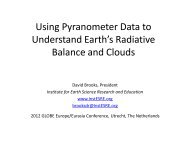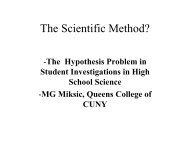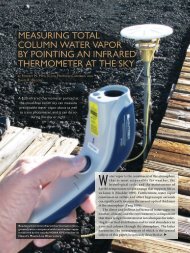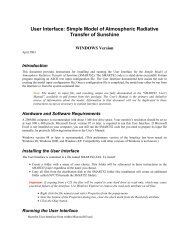Estimating Cloud Type from Pyranometer Observations - American ...
Estimating Cloud Type from Pyranometer Observations - American ...
Estimating Cloud Type from Pyranometer Observations - American ...
Create successful ePaper yourself
Turn your PDF publications into a flip-book with our unique Google optimized e-Paper software.
JANUARY 1999 DUCHON AND O’MALLEY<br />
139<br />
TABLE 4. Same as Table 2 but for November 1995.<br />
<strong>Cloud</strong> type <strong>from</strong> human observation<br />
No clouds<br />
26<br />
Cirrus<br />
2<br />
Cumulus<br />
10<br />
Cirrus and cumulus<br />
4<br />
Stratus<br />
1<br />
Precipitation–fog<br />
0<br />
Other<br />
3<br />
No<br />
clouds Cirrus Cumulus<br />
10<br />
5<br />
8<br />
9<br />
0<br />
0<br />
2<br />
<strong>Cloud</strong> type <strong>from</strong> pyranometer method<br />
0<br />
3<br />
13<br />
7<br />
0<br />
0<br />
14<br />
Cirrus and<br />
cumulus<br />
0<br />
0<br />
8<br />
3<br />
4<br />
1<br />
3<br />
Stratus<br />
0<br />
0<br />
1<br />
0<br />
5<br />
0<br />
0<br />
Precipitation–<br />
fog<br />
0<br />
0<br />
0<br />
0<br />
0<br />
0<br />
0<br />
Other<br />
0<br />
0<br />
3<br />
2<br />
3<br />
2<br />
3<br />
nometer method can predict cirrus when the human observer<br />
records only cumulus (as shown in Tables 2–4).<br />
c. Comparisons among pyranometer ‘‘other’’ and<br />
cumulus and stratus<br />
Table 2, especially, shows that there are a number of<br />
occurrences in which the pyranometer method produces<br />
‘‘other’’ cloud type, while the cloud type derived <strong>from</strong><br />
human observation is cumulus or stratus. With regard<br />
to the other–cumulus comparison, it was initially<br />
thought that the differences were due to viewing the<br />
sides of cumulus at large zenith angles. An investigation<br />
showed that while this can be case, the differences occurred<br />
at all times of day. It was thought also that the<br />
other–stratus differences were due to sharp cloud boundaries<br />
but, again, this was not always the case. The explanation<br />
is as follows.<br />
At the outset of the comparison effort, a number of<br />
decisions were made concerning how to provide a useful<br />
comparison of the two methods. One in particular dealt<br />
with classifying stratocumulus clouds. During winter<br />
months at the SGP site, stratocumulus clouds are frequently<br />
reported. Because the pyranometer method cannot<br />
be used to classify stratocumulus due to the wide<br />
range in irradiance signal <strong>from</strong> effectively cumuloform<br />
to stratiform clouds, for comparison purposes, we classified<br />
the observer-reported stratocumulus into two categories.<br />
If the reported stratocumulus coverage was 8/<br />
10 or less, we classified the observation as cumulus; if<br />
the stratocumulus coverage was 9/10 or 10/10, it was<br />
classified as stratus. The former criterion corresponds<br />
to traditional broken and scattered clouds, the latter to<br />
overcast conditions.<br />
In Fig. 5 stratocumulus clouds occur in a band extending<br />
<strong>from</strong> approximately the center of the stratus area<br />
upward to the right to include the lower left 1/9 of the<br />
cumulus area. Most of the occurrences of other–cumulus<br />
and other–stratus mismatches arose when stratocumulus<br />
was reported, and the pyranometer method yielded values<br />
of irradiance ratios between 0.40 and 0.65 and standard<br />
deviations between 25 and 80 W m 2 , that is, the<br />
space to the right of the stratus area and below the<br />
cumulus area in Fig. 5.<br />
In the majority of cases of reported stratocumulus for<br />
1995, however, a favorable comparison occurred. That<br />
is, most of the cumulus and stratus classified <strong>from</strong> stratocumulus<br />
clouds by the scheme described above lie<br />
within the cumulus and stratus areas, respectively, as<br />
determined by the pyranometer method.<br />
d. Other differences<br />
Other systematic differences occur. Table 2 for January<br />
1995 shows six occurrences of stratus <strong>from</strong> the<br />
pyranometer method and cumulus <strong>from</strong> the human observer.<br />
Some other months (not shown) indicate similar<br />
values. Many of these differences occur when stratocumulus<br />
was reported. Thus the pyranometer method<br />
predicted cumulus (stratus), while the stratocumulus<br />
classification scheme yielded stratus (cumulus). Table 3<br />
for August 1995 shows six occurrences of stratus <strong>from</strong><br />
the pyranometer method and precipitation–fog by the<br />
observer. This discrepancy results because the same irradiance<br />
conditions can occur for both heavy stratus and<br />
precipitation–fog, while Fig. 5 shows a unique separation<br />
between them.<br />
In Table 4, November 1995, there are 14 cases in<br />
which the pyranometer method yields cumulus when<br />
the human observer classification is other. These differences<br />
arise <strong>from</strong> having three cloud layers (low, middle,<br />
high). Due to the transition <strong>from</strong> when the sun path<br />
is essentially clear to when it is completely blocked, the<br />
standard deviation exceeds 100 W m 2 . Due to scattering<br />
<strong>from</strong> the sides of cumulus clouds, the measured<br />
irradiance exceeds clear-sky irradiance and the irradiance<br />
ratio for the 21-min window is greater than 0.5.<br />
As seen in Fig. 5, the pyranometer method will classify<br />
the cloud type as cumulus.<br />
6. Combining categories<br />
Figure 10 shows the frequency of occurrence of the<br />
seven cloud types using the pyranometer method and<br />
the human observer method for each month in Tables<br />
2–4. The frequency of occurrence is defined as the ratio<br />
of the column (or row) sums, as appropriate, to the sum<br />
of column (or row) sums. Among these, as well as the











